This is a guest post from reader Roger Wilson.
I want a proper strategic level PT network for Auckland. As a regular region-wide PT user, the lack of a strategic network is the biggest single impediment to getting about efficiently. We already, sort of, have one, but there’s precious little “net” in our network. Every single line is focused on bringing people into the central city. Which is great as far as it goes, but the missing ingredient is connectivity:
All is not lost, though. The Auckland Transport Alignment Programme (ATAP) outlines a future Rapid Transit Network (RTN) which won’t be half bad. If it is built. The problem is that much of it is ten years (or more) away while argument rages about mode and who will pay for what. I don’t want to wait ten years plus for a proper strategic network. I want progress now and completion by the time the CRL opens. And perversely, Covid-19 may provide the opportunity.
One Covid-19 impact is the likely reduction in peak-hour PT travel into the central city. Although the extent of the reduction isn’t yet clear, some major businesses now have staff working from home as a matter of course, assisted by video conferencing. Some major bus routes could probably operate with fewer peak hour services – moving from every two-three minutes to every three-four minutes will be completely unnoticed by most. Peak services are economically challenging, given many buses operate only one or two services morning and evening. “Liberated” bus resources could be reallocated to all day RTN routes.
Another Covid impact is the huge amount of borrowing by government, which will limit its options for funding RTN mega-projects in future years. Few RTN routes qualify as “shovel-ready” for immediate investment, so let’s not hold our breath awaiting Covid-recovery funding to advance heavy or light rail. It is possible, however, that funding could be available for interim interchanges, for example, on the north-western line. Like central government, Auckland Council will also rein in spending – the proposed emergency budget illustrates this. Mega-projects on the scale needed to deliver the ATAP RTN will not be front of mind. Inevitably, most Auckland public transport improvements over the next few years will be necessarily bus-based.
Debate on a strategic network tends to focus on individual lines – should they be heavy rail, light metro, light rail, bus or even tram-bus? As a PT user, I really don’t care. The most important factors are priority, speed, limited stops, frequency – and genuine connectivity across the region. The network is already planned; a Covid-19 “reset” could bring it forward:
The RPTP 2018 outlines the timeline for the development of the PT network in detail. It’s actually quite impressive in adding new bus routes, expanding others from “Connector” status to “Frequent” and filling in gaps, though there’s room to quibble over details.
With a combination of resources culled from the peak-of-peak operation and resources already earmarked for new routes, what could be achieved in the short term?
Three initiatives which contribute to the RTN are identified in the RPTP for 2021. First, a new route opens from New Lynn to the Airport, though not yet to RTN frequencies. Second, Route 110 (Westgate via the NW Motorway) will become “frequent”. Auckland Transport is already considering constructing a Westgate interchange and an interim Te Atatu interchange (see https://www.greaterauckland.org.nz/2020/01/13/proposed-staging-for-the-nw-rtn/). With a small amount of additional resource, the route could be extended to Brigham Creek and Kumeu. And third, the Airport-Manukau link should be completed.
All these routes could be designated “strategic” lines by a combination of (a) making them limited stop (the Airport-Manukau link will be and much of the 110 already is) and (b) implementing 24/7 bus lanes and signal pre-emption/priority. Creative thinking around interchanges would be needed, and it’s not a full “rapid” transit solution, but it’s a good stopgap to serve public needs. I don’t want to wait a decade for something gold-plated.
Adding these lines puts more “net” into the network, especially for users in the city’s inner south. With a minor reallocation of resources this could be Auckland’s strategic network next year:
When the first stage of the Eastern Busway opens, the all of the planned Ellerslie-Botany-Manukau corridor could be included in the “strategic” network, given 24/7 bus lanes and signal pre-emption and priority. Peak hour buses made redundant by Covid could provide the operational resources required. Connectivity is further significantly enhanced in this 2022 network, and a route map could look like this:
The next landmark is the opening of the CRL in 2024, changing rail routings through the central city. Three more RTN routes are also foreshadowed and will contribute to the overall network:
First, the Dominion Road to Airport route. Light metro or whatever, some form of enhanced service is needed to serve the airport and poorly connected areas south of the Manukau Harbour, and for increased capacity on Dominion Road itself. It would have to be operated by bus (with all the attendant bus congestion) if implemented in 2024.
As an aside, Covid must surely be badly hurting Skybus, and the time may be ripe for Skybus to be included under the PTOM umbrella. Skybus could possibly be subsumed into an interim limited-stop Dominion Road and Airport line.
The second enhancement is the Henderson-Westgate-Constellation route, which moves to frequent services once the Northwest line is constructed. And the third is the conversion of Route 866 (Albany-Newmarket) to become the “frequent” NX3. This is planned for around 2028, but it would enhance network connectivity if brought forward. These three routes, plus the Devonport ferry (already proposed for the strategic network), the CRL, the post-Penlink plan to extend the NX2 to a Whangaparaoa Station (though possibly not by 2024), and a spur to Takapuna, almost complete the RPTP network, with great connectivity:
Note that ALL of these enhancements are already foreshadowed; it’s simply a question of timing and mode, and applying bus priority measures which are mostly already in the RPTP.
Consistent branding is required for the strategic, bus train and ferry network – the acronym “RTN” just doesn’t cut it. How about AT Rapid, AT MetroExpress or AT Transurban as possibilities? The branding and the route map should be mercilessly promoted and become part of Aucklanders’ daily language.
How to identify individual lines – should they be named, numbered, or given a letter? I favour letters to distinguish them from the rest of the network, like the “W” notation which already appears on some Western Line signage. I like the idea of each line also being named. Line U, for example, could be the Upper Harbour Line. But whatever the nomenclature, it should be simple and easily understood by all.
We can’t allow a “good” strategic network to become the enemy of the “best”, given the “best” won’t happen for many years. None of this precludes future upgrades to rail, light metro, light rail or tram-bus. The key question is whether it is better to have a fully connected strategic network soon or effectively have none at all for the foreseeable future?
The onus rests with Auckland Council and central government to get this moving. Each year AC outlines its expectations of AT in its Letter of Expectation (LOE). AT’s Statement of Intent (SOI) documents how it will implement the LOE. It’s too late for the 2020-21 financial year, but the process starts again in early 2021 for the 2021-22 year. So how about it, Councillors? Bang for buck and all that?
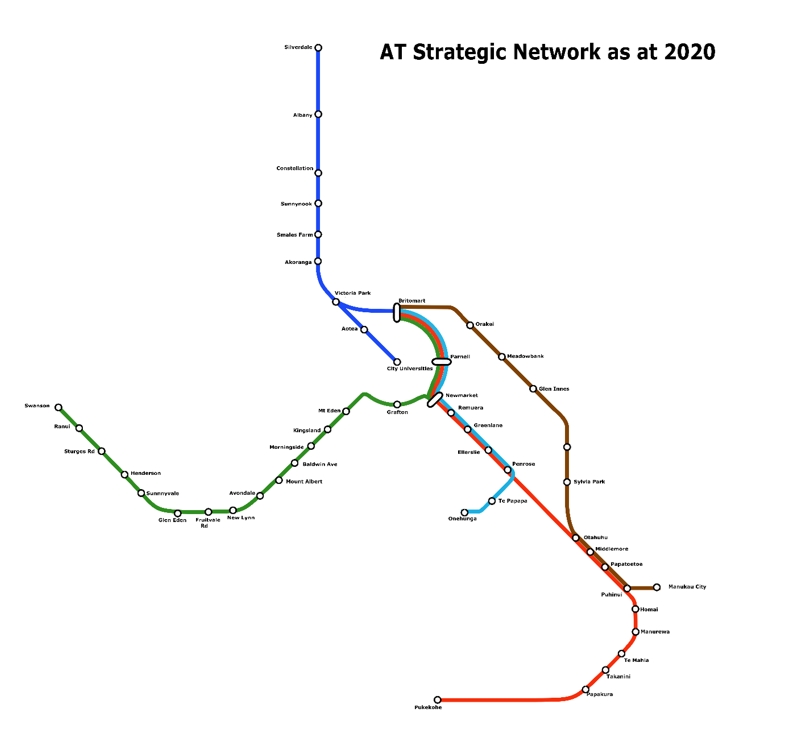
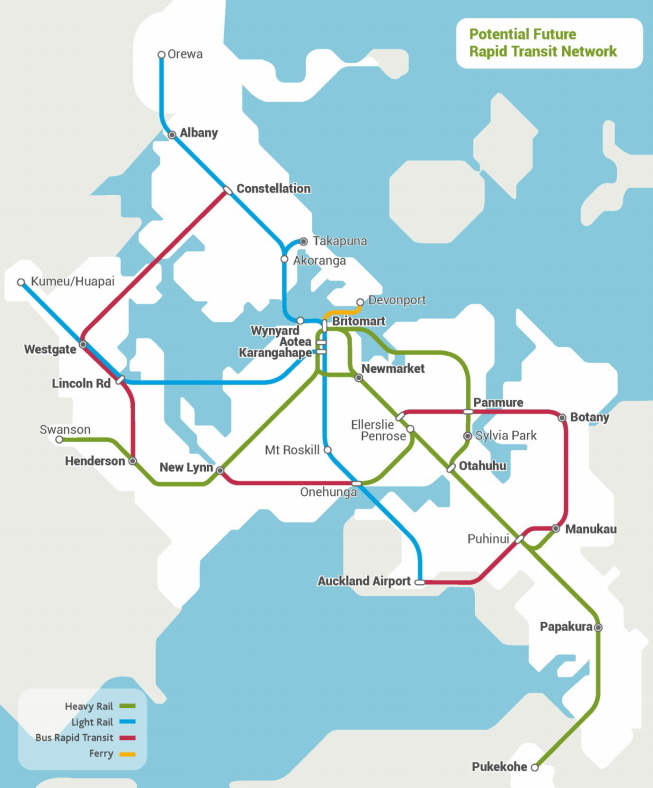
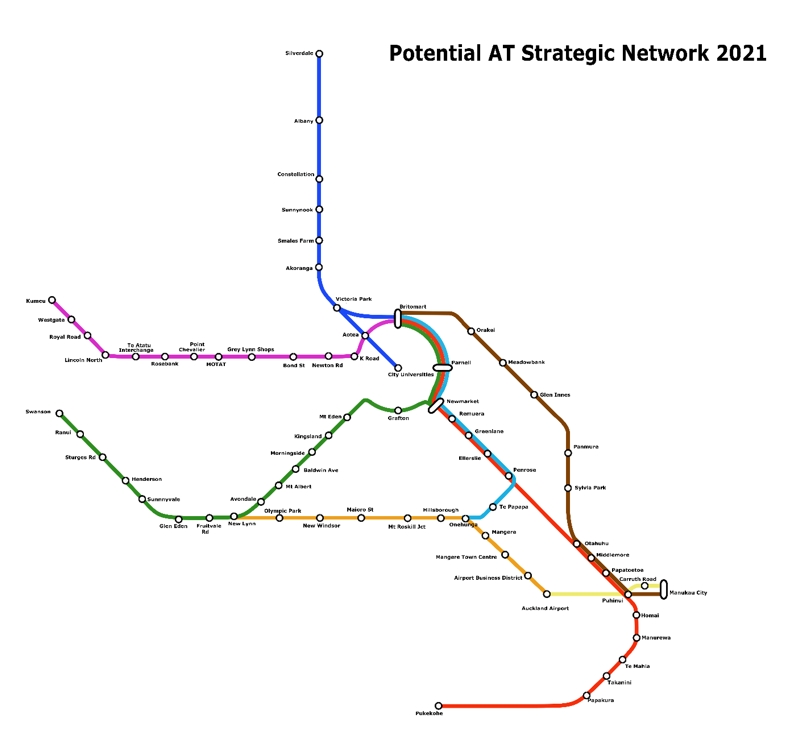
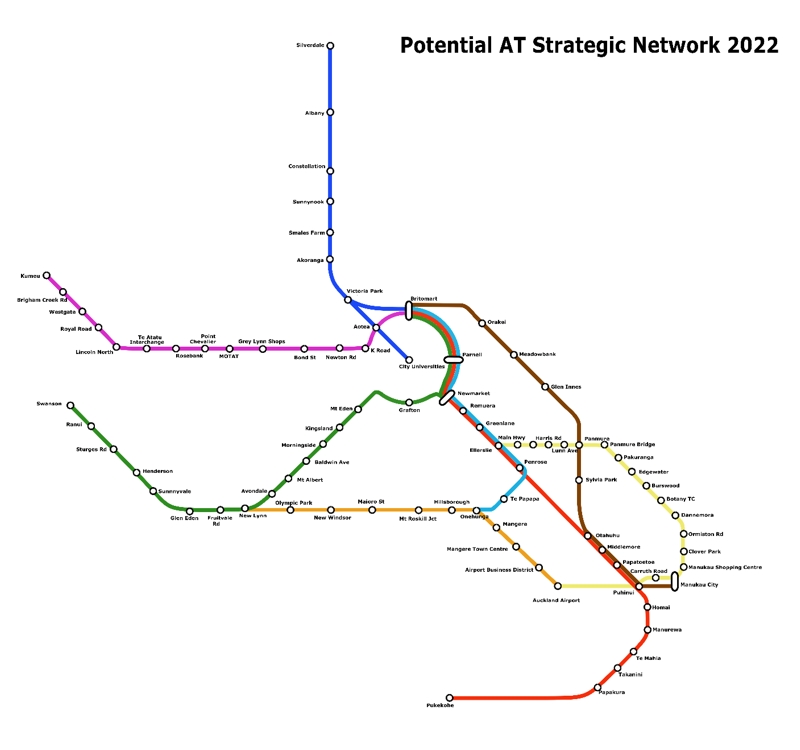
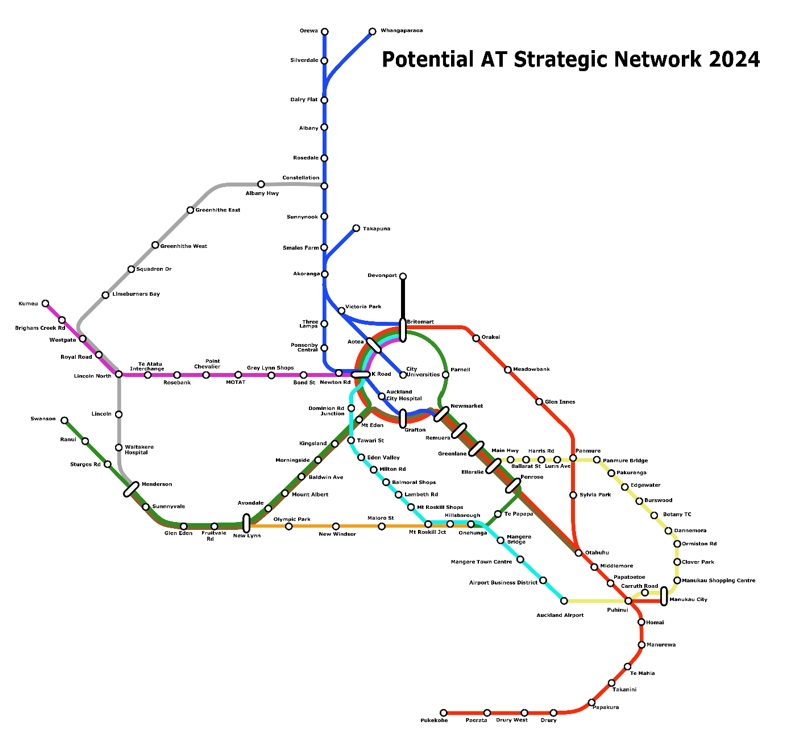

 Processing...
Processing...
This is really good. Getting that northwest line up and running is surely the top priority.
AT Rapid sounds like a good brand. Would put pressure on AT to make these services fast.
I’m not sure how ‘rapid’ a North West journey would be if it has to meander past the Grey Lynn shops etc. From memory this was also an issue with Light Rail routes people kept suggesting. Many ended up creating a massively long journey for those in the area the line is set up to serve, just so those in the inner suburbs would have access to yet another mode.
Bus lanes on the motorway shoulders are going through to Newton Rd
What about:
AT Not As Slow
AT Almost Usable
AT Rapidish
AT Optizorb
Seriously though I do think that they need to do more with buses. I’d like to see some research on the types of buses available that could suit our roads. The more a bus looks and acts like a train the more use it will get. I really don’t get the steel wheel obsession, I don’t get why we can’t have something almost as good for less than 1/10th of the price.
The steel wheel obsession is simple, steel wheels on steel on steel rails use way less energy than rubber on road, less than a quarter in the case of some freight trains vs trucks.
A small operating cost (or energy) saving doesn’t matter if you are spending way more building the thing in the first place.
Rail can make sense when the demand is there but the efficiency argument is mostly a red herring.
It’s not only energy efficiency that needs to be considered, but capacity. A six car EMU can carry circa 750 people which is equivalently to 7.5 double deck buses and many more single deck vehicles. And of course for each bus, there is a need for a driver…..
If Auckland had congestion road pricing then does the motorway network become a bus rapid transit network?
If the definition of rapid transit is fast frequent and reliable then motorways that a free flowing for buses because of congestion charging fits that description. Doesn’t it?
Not really. It’s hard to have stations on the motorway so you just end up with a series of point-to-point express services.
They should convert the entire network to tram-bus. Heavy tram-bus, not that light tram-bus rubbish!
[heavy mouth breathing]
Sorry I came as fast as I could had to kick the wife off the phone so the modem could connect. Auckland can never solve its transport problems with buses because a bus can only carry 5% of the people that train can we need to be bold and replace all our bus routes with railways and it must be heavy I’ll have none of this light rail fad. New Zealand has built more than 4000km of railways and it can do so again I’ve costed it based on my time at the railways department and it’ll only be £5 / 6d might even be cheaper cause with the pandemic there’s plenty of people on the dole we can recruit for track laying gangs.
– John Smith
Engineer (retired)
chef’s kiss
It’s great idea. And probably worth implementing as it will be easier for council/government to implement and easier to justify less spending. But we have to acknowledge that it would mean abandonment of all those ‘great network’ project like light rail etc. Now they can at least justify it with city having bad network. If we have a good one no one will even touch those projects. But again I guess it’s better to have something rather than just counting on something great and have nothing (and with current council/government that is the case, lots of promises, no actions).
I would have thought a bus from Te Atatu to the airport via the tunnel would be useful. It would be useful if buses from New Lynn, Water view, Mount Roskill and the central city could run on the motorway and not have to detour into the likes of Onehunga, Mangere bridge and Mangere town center. Could stops be placed at appropriate pull off points next to over bridges or under bridges along state highway 20 and 20a. When users work out the time savings maybe they would be prepared to walk the extra distances to access them. Have a look at a map in each case the walk would only be 200 metres. Mangere Bridge and Mangere Town Center have feeder stops for the 380 bus near to the over bridges. Onehunga requires a bit more of a walk down to the harbour edge where there is an underbridge tunnel which would give access to stops on both sides of the motorway. I imagine the concept could be used at other places on the Motorway network I haven’t studied it.
I think it’s better than ATAP, and certainly much more affordable.
It’s immediately obvious that more work is needed on the North Shore side of things to cover both east and west of the busway (eg Birkenhead, Browns Bay, the Devonport peninsula) but these can easily added in and will be.
I’m looking forward to seeing the next iteration of this. It’s refreshing to get away from grand engineer-led projects like light rail that don’t do anything to light up the dark spaces in the public transport network.
At the risk of derailing the thread, the Light Rail proposals definitely offered an additional to areas that currently have little in the way of transport connections – e.g. Mangere, North West Auckland.
Whilst I support a north western busway to Massey…
…for it to mean much will take ongoing investment of many millions of dollars worth of civil engineering works over the euros of about a decade or so.
The Western line service should be extended to Huapai using the existing infrastructure (which is receiving an upgrade now anyway) until such time as LR/BRT reaches there (at least 10 years). Is such a waste of that infrastructure in an area poorly served by PT and one that is one of the fastest growing populations in Auckland.
+111
As others have said before, limited stops works only if attention is given to the quality of the walking connections between stops.
Marin County (San Francisco Area) California has a very successful bus service working along the motorway. It makes a viable alternative to a car, as it has limited stops and goes the shortest distance. Refer to their interactive map https://marintransit.org/map Route 71X , 36. Similar to Northern Express. Make Diamond or HOV lanes on the motorway. It is important to have effective feeder bus network to these stations. Consider using Mini Bus routes that can be hailed like a taxi and are more adaptable to some narrower streets. A bit of lateral thinking can make a difference.
There’s a huge opportunity in significantly improving bus priority and service on major arterials (esp the old tram network) and major crosstown routes, such as Balmoral Rd.
But note these cannot be designed like the Eastern Busway, massive land take, housing removal, huge traffic lane and intersection upsizing, and enormous cost. This is simply unaffordable as well as undesirable; transport must serve land use, not bulldoze it.
Existing traffic and parking lanes must be repurposed, intersections reduced from every turning lane so the transit lane is contiguous. Consider these as proper Frequent routes, or maybe brand them as Super-Frequents (SuperFreak) or something.
This is of course should be the outcome of AT’s Connected Communities programme. Which appears stuck, probably because consultants are running the standard traffic model = ‘computer says no’. Well bin the model, use your brains (especially on how to fit safe cycleways in there too).
https://theconversation.com/modelling-for-major-road-projects-is-at-odds-with-driver-behaviour-63603
+1
+2
+1
Light Rail needs to be built now. It should be shovel ready.
#VoteNational
Why vote for those corrupt bunch of bunnies , haven’t you watched te news lately ? .
Hahahahahahahahahahahahaahahahahaahahaahahaahahahahahahahahaahhahaahahhahahahahahahahaahahahhaahahhahhahahahahaahahahhahahahahahahahahahhahahahahahahahahahahhaha. Nah mate Vote Green
Thanks for the post.
The 120 – Henderson to Westgate and Constellation is over perfoming and long overdue for a frequent service.
The 110/Northwestern Express needs to become frequent. There is a bus lane on the motorway from Westgate to Lincoln but only two 125X buses use that motorway each weekday.
Because of the lack of frequency of both services I find it easier to take the 126 bus to Albany from Westgate and the NX2 to university. Less chance of getting wet.
The Waitakere Local Board were investigating trial bus services from Piha to Glen Eden, and Huia to New Lynn.
Hopefully the trial buses coincide with the opening of the CRL so as to maximize the leverage CRL will give those trial bus services.
It’s not only energy efficiency that needs to be considered, but capacity. A six car EMU can carry circa 750 people which is equivalently to 7.5 double deck buses and many more single deck vehicles. And of course for each bus, there is a need for a driver and some of that congested road space….
let us push politics aside for now